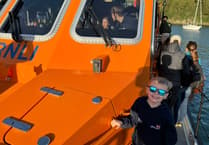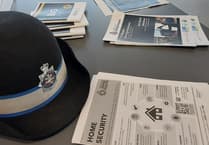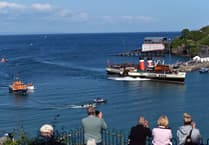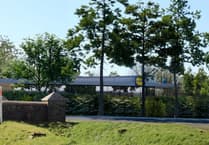This year marks the 150th anniversary of the foundation of a lifeboat station in Tenby.
Although records show there was a history of lifesaving at sea in Tenby for years before - a silver medal was awarded to John Ray for helping to rescue, along with 11 other men in two boats, three men from the sloop Mary in 1834 - the first station was established in the town by the Shipwrecked Mariners Society in 1852.
Two years later, it was handed over to the RNLI, beginning an association unbroken over three centuries.
Over the years, the brave mariners of Tenby have been awarded 10 silver medals and five bronze medals for their gallantry at sea, with three silvers being awarded in the first 10 years of the setting up of the station.
Two were awarded in 1856 and another two in 1859.
The first was to Lieut. R. Jesse, chief officer of Coastguard, for his gallant conduct in rescuing the crews of the schooners Agenoria and Alexandre, while chief bowman, Robert Parrott, of Tenby Coastguard, was awarded the second in that year for his repeated services in saving lives from shipwreck over the previous 21 years.
Robert Parrott was awarded his second-service clasp three year later when, as coxswain, he assisted in the rescue of the crew of the brig Policy, while the Hon. Lieut R. F. Boyle RN received the same award for the same rescue.
The first lifeboat house was built in 1862 at a cost of £190 and the following year the first named lifeboat, the Florence, arrived in the town to replace the lifeboat transferred to the RNLI by the Shipwrecked Mariners Association 10 years earlier.
The Florence was renamed the Carolina Morris' Divine Rescue in 1876 and remained in service until 1885, when the first self-righting lifeboat, the Anne Collin, arrived.
In 1875, coxswain Thomas Monger was awarded the silver medal for his long service in the lifeboat and in 1895 a new lifeboat house was constructed, although costs had by this time escalated to £600!
In 1896, the Tenby station came under investigation over the high number of helpers turning out at launches - on two occasions as many as 97 and 106 - and a year later a head launcher was appointed, with an approved maximum number of helpers set at 50 for services and 40 for exercises.
After 16 years service, the Anne Collin was replaced in 1902 by the William and Mary Devey, while in 1910 the old lifeboat station was handed over to Tenby corporation.
The new lifeboat station was adapted in 1920, at a cost of £10,000, to take its first motor lifeboat and the John R. Webb came on station in 1923.
It remained in service until 1930, when it was replaced by a second John R. Webb, which remained on station until 1955.
In 1938m acting coxswain John Rees was awarded a silver medal and motor mechanic Alfred Cottam a bronze medal for their part in saving eight men from the steamer Fermanagh in hurricane force winds in January of that year.
In 1946, several members of the crew were injured on a call to the St. Govan's light vessel when the rough sea broke over the lifeboat. One crewman, Frank Hooper - who had served on the lifeboats since 1916 - was injured so badly that he never worked again and was granted a pension of £2.10. 0d a week for life by the Institution.
A special Centenary Vellum was awarded in 1952, while the following year coxswain Thomas Richards was awarded the silver medal and crew members William Thomas and William Rogers the bronze medal for their part in the rescue of the seven crewmen of the St. Govan's light vessel.
Two years later, Tenby's longest serving lifeboat to date, the Henry Comber Brown, arrived, while in 1959 the RSPCA honoured the coxswain and crew at Tenby for the rescue of two cows which had fallen over the cliffs at Manorbier.
In 1963, a letter of appreciation, signed by the chairman of the RNLI, was sent to the coxswain and crew for launching in a Force 10 storm and 20 to 25 feet high waves to go to the assistance of the Kilo off Caldey Island.
Crew member Michael Wilson and bowman Joshua Richards were both honoured in 1966 with silver and bronze medals, respectively, when they rescued six children trapped by the tide near Waterwynch.
The lifeboat was launched to assist, with Wilson and Richards manning the punt to get closer to the shore.
While Richards kept the punt close to the cliffs, Wilson swam, with a line attached to him, from the punt to the cliffs and back again until all the children had been safely rescued.
Wilson's gallantry also earned him the Maud Smith award for the bravest act of life-saving by a member of a lifeboat crew that year.
A framed letter of thanks signed by the chairman was awarded to Ivor Crockford and a letter of thanks signed by the secretary was awarded to assistant mechanic R. Thomas in recognition of their service when the lifeboat escorted the Manta to harbour in 1968.
The chairman also sent a framed letter of thanks to the coxswain and crew the following year following their attempts to rescue a boy who had fallen over cliffs at Manorbier.
Although tragically the boy could not be saved, the chairman praised the crew's repeated attempts to rescue him under difficult conditions and made special reference to the part played by the crew of the punt, Joshua Richards, John John and Michael Crockford.
Over the years, when called upon to carry out rescues close in to the cliffs, the lifeboat always took a punt in tow, but in 1972, Tenby took delivery of a D class inflatable inshore lifeboat - although it was another four years before its own specially built lifeboat house was constructed!
As coxswain in 1982, Joshua Richards was awarded the bronze second-service clasp for his courage and seamanship in the rescue of the sole occupant of the catamaran Helen-M, a rescue which also saw the Thanks of the Institution on Vellum accorded to crew members John John and Michael Wilson.
A year later, the Thanks of the Institution on Vellum were also accorded to present coxswain Alan Thomas and crew member Charles Crockford when, using the ILB, they rescued two boys cut off by the tide.
In September of the same year, crew member Nick Tebbutt put out from the lifeboat in an inflatable dinghy to assist in the rescue of the five occupants of the yacht Sailing Bye, an action that also earned him the Thanks of the Institution on Vellum.
In 1986, the Henry Comber Brown was replaced with the present lifeboat, the Tyne-class RFA Sir Galahad, and the lifeboat station was adapted to accommodate this new vessel.
Major repairs were also carried out on the slipway at the time, while three years later a side extension was constructed to provide a mechanic's workshop and a souvenir sales outlet.
The Thanks of the Institution on Vellum were accorded to helmsman Dennis Young and crewmates John John, William James and Roy Young when, using the ILB, they rescued an injured swimmer from rocks off Monkstone Point.
Coxswain Alan Thomas was awarded the silver medal, and the Maud Smith Award for bravery in 1990 in recognition of his outstanding courage, determination and fine seamanship, when the lifeboat went to the assistance of two fishing vessels in a Force Nine gale.
The skipper of the fishing vessel Silver Stream was trapped in his wheelhouse and Mr. Thomas showed great skill and courage to manoeuvre the lifeboat into position to enable the man to be pulled through the wheelhouse window to safety by lifeboat crew. The two crew members from the other fishing boat, the New Venture, were also saved.
The RNLI's committee of management have commemorated Tenby lifeboat station's 150th anniversary with a Vellum, while a further honour was bestowed in Her Majesty The Queen's New Year Honours List when former mechanic, Charles Crockford, was awarded the MBE.
Over the last 150 years, the Tenby lifeboat, in its various guises, has been launched 949 times and has been instrumental in the saving of 519 lives.
Since arriving in Tenby in 1972, the ILB has been launched 1,158 times, saving 388 lives.
It is certainly a proud record and, with a new lifeboat station to be built in the near future to accommodate the new FSB2 lifeboat, one which looks set to continue for many more years to come.




